SOLVING WORD PROBLMS ON PYTHAGOREAN THEOREM
Subscribe to our ▶️ YouTube channel 🔴 for the latest videos, updates, and tips.
Problem 1 :
A rectangle has sides of length 7 cm and 3 cm. Find the length of its diagonals.
Solution :
In a rectangle, the diagonal will divide the rectangle into two right triangles.
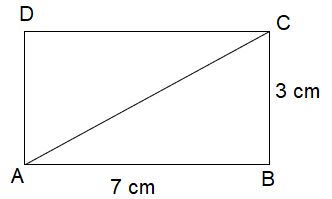
x2 = 900/10
AC2 = AB2 + BC2
AC2 = 72 + 32
AC2 = 49 + 9
AC2 = 58
AC = √58
AC = 7.61 cm
Problem 2 :
The longer side of the rectangle is double the length of the shorter side. If the length of a diagonal is 10 cm, find the dimension of the rectangle.
Solution :
Let x be the length of the shorter side.
Longer side = 2x
In rectangle, the diagonal side is hypotenuse.
So,
102 = x2 + (2x)2
100 = x2 + 4x2
5x2 = 100
x2 = 100/5
x2 = 20
x = 2√5 cm
Longer side = 2(2√5) ==> 4√5 cm
Problem 3 :
A rectangle with diagonals of length 30 cm has sides in the ratio 3 : 1. Find the
(a) Perimeter (b) Area of the rectangle.
Solution :
Let "3x" and "x" be the length and width of the rectangle respectively.
Using Pythagorean theorem.
302 = (3x)2 + x2
900 = 9x2 + x2
900 = 10x2
x2 = 900/10
x2 = 90
x = √90
x = 3√10 (width)
3x = 3(3√10) ==> 9√10 (Length)
(a) Perimeter = 2(length + width)
= 2(9√10 + 3√10)
= 2 (12√10)
= 24√10 cm
(b) Area of the rectangle = length x width
= 9√10 x 3√10
= 27 (10)
= 270 cm2
Problem 4 :
A rhombus has sides of length 7 cm. One of the diagonals is 10 cm long. Find the length of the other diagonal.
Solution :
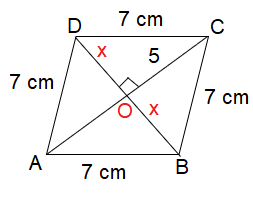
In rhombus, diagonals will bisect each other at right angle.
Triangle DOC
DC2 = DO2 + OC2
72 = x2 + 52
49 = x2 + 25
49 - 25 = x2
x2 = 24
x = 2√6
Length of other diagonal = 2x ==> 2(2√6) ==> 12√6 cm
Problem 5 :
A square has diagonals of length 8 cm. Find the length of the sides.
Solution :
Let x be the side length of the square.
x2 + x2 = 82
2x2 = 64
x2 = 32
x = √32
x = 4√2
So, side length of the square is 4√2.
Problem 6 :
A rhombus has diagonal of length 4 cm and 6 cm. Find the perimeter.
Solution :
In any rhombus, the diagonals will bisect each other at right angle.
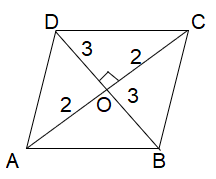
In triangle DOC
DC2 = DO2 + OC2
DC2 = 32 + 22
DC2 = 9 + 4
DC2 = 13
DC = √13
Perimeter of rhombus = 4√13.
Problem 7 :
An equilateral triangle has sides of 6 cm
(a) Find the length one of its altitude.
(b) Find the area of the triangle.
Solution :
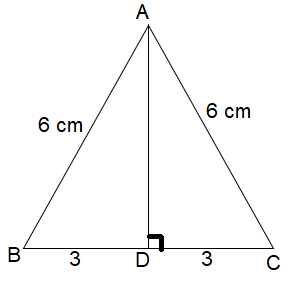
(a) Using Pythagorean theorem :
AC2 = AD2 + DC2
62 = AD2 + 32
36 - 9 = AD2
AD2 = 27
AD = 3√3
(b) Area of the triangle = (1/2) x base x height
= (1/2) x BC x AD
= (1/2) x 6 x 3√3
= 9√3
Problem 8 :
An isosceles triangle has equal sides of length 8 cm and the base of length 6 cm.
(a) Find the altitude of the triangle
(b) Find the area of the triangle
Solution :
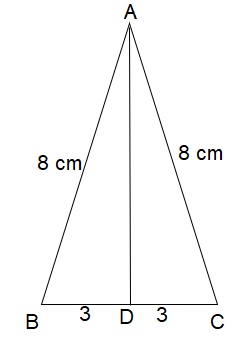
(a) Using Pythagorean theorem :
AC2 = AD2 + DC2
82 = AD2 + 32
64 - 9 = AD2
AD2 = 55
AD = √55
(b) Area of the triangle = (1/2) x base x height
= (1/2) x BC x AD
= (1/2) x 8 x √55
= 4√55 cm2
Problem 9 :
The backboard of the basketball hoop forms a right triangle with the supporting rods, as shown. Use the Pythagorean Theorem to approximate the distance between the rods where they meet the backboard.
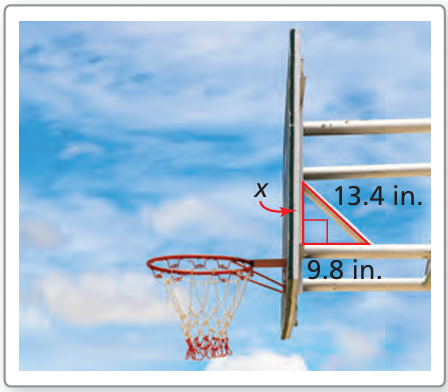
Solution :
Using Pythagorean theorem,
13.42 = x2 + 9.82
179.56 = x2 + 96.04
x2 = 179.56 - 96.04
x2 = 80.52
x = √80.52
x = 8.97
Approximately 9 inches
So, the distance between the rods where they meet the backboard is 9 inches.
Problem 10 :
The fire escape forms a right triangle, as shown. Find the distance between the two platforms.
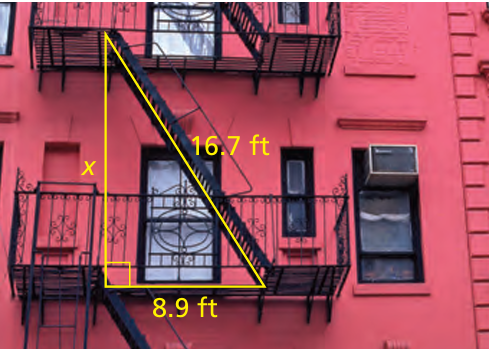
Solution :
Using Pythagorean theorem,
16.72 = x2 + 8.92
278.89 = x2 + 79.21
278.89 - 79.21 = x2
x2 = 199.68
x = √199.68
x = 14.13
Problem 11 :
Approximate the wingspan of the butterfly.
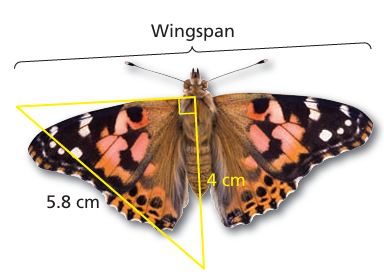
Solution :
Let x be the width of the wingspan of butterfly
5.82 = x2 + 42
33.64 = x2 + 16
x2 = 33.64 - 16
x2 = 17.64
x = √17.64
x = 4.2
So, the width of the wingspan is 4.2 cm.
Problem 12 :
The legs of a right triangle have lengths of 28 meters and 21 meters. The hypotenuse has a length of 5x meters. What is the value of x ?
Solution :
Let x be the width of the wingspan of butterfly
(5x)2 = 282 + 212
52x2 = 784 + 441
25x2 = 1225
x2 = 1225/25
x2 = 49
x = 7
So, the required value of x is 7 meters.
Subscribe to our ▶️ YouTube channel 🔴 for the latest videos, updates, and tips.
Recent Articles
-
Finding Range of Values Inequality Problems
May 21, 24 08:51 PM
Finding Range of Values Inequality Problems -
Solving Two Step Inequality Word Problems
May 21, 24 08:51 AM
Solving Two Step Inequality Word Problems -
Exponential Function Context and Data Modeling
May 20, 24 10:45 PM
Exponential Function Context and Data Modeling